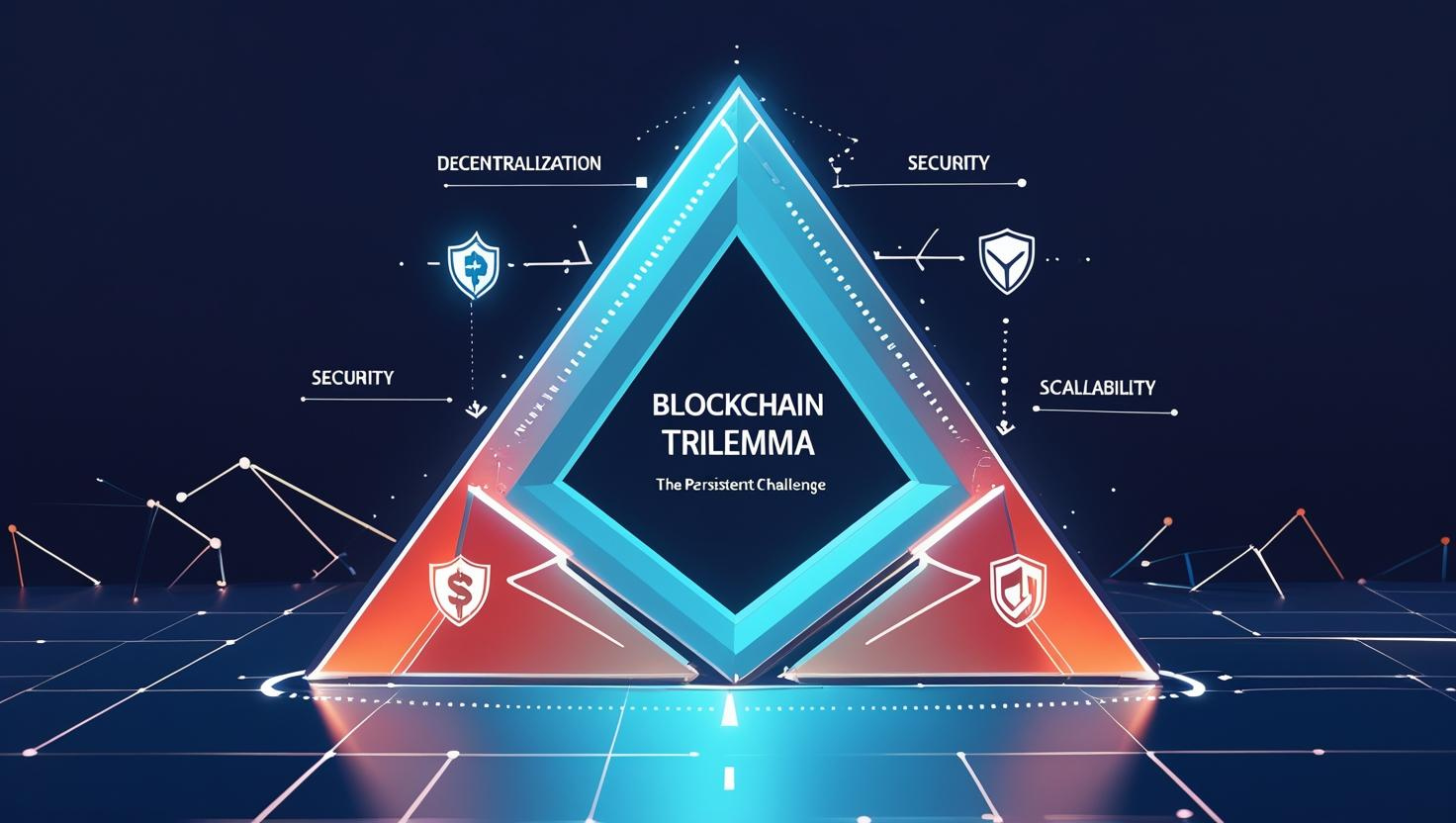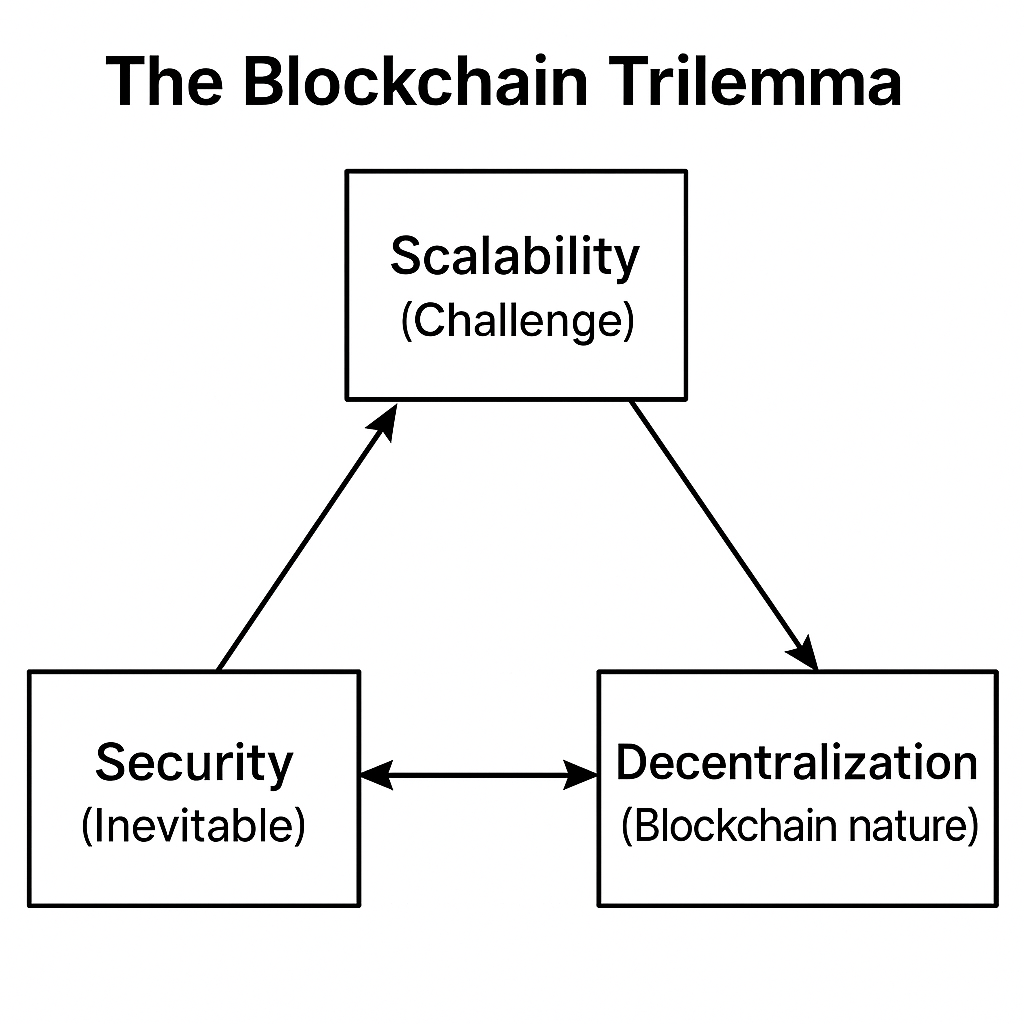The blockchain trilemma challenge
The blockchain trilemma suggests that any blockchain can fully achieve only two out of these three goals—decentralization, security, and scalability.
Blockchain technology is now being adopted across industries like finance, logistics, healthcare, and even government, thanks to its core qualities: decentralization and security.
Decentralization removes the need for a central authority, since no single bank, government, or corporation has full control over the blockchain network. This gives all participants equal access and eliminates single points of failure. Security, on the other hand, protects data integrity and ensures that transactions can’t be altered or faked once recorded.
However, as blockchain attracts more users due to its secure and decentralized nature, several significant challenges emerge:
- Transaction processing slows down.
- Networks become more expensive to operate.
- The system becomes less user-friendly.
To solve these challenges, blockchains must improve their performance (scalability). They need to handle more users and transactions without sacrificing their core qualities. This is where the challenge begins. Making a blockchain faster often means giving up some decentralization or weakening security. This trade-off, known as the Blockchain Trilemma, was first explained by Ethereum co-founder Vitalik Buterin in his article, The Limits to Blockchain Scalability.
The blockchain trilemma suggests that any blockchain can fully achieve only two out of these three qualities: decentralization, security, and scalability.
Understanding the blockchain trilemma through trade-offs
To understand why this presents such a fundamental challenge for blockchain developers, we need to examine what happens when networks attempt different combinations of these three qualities. Each approach reveals specific trade-offs that explain why no blockchain has yet achieved all three goals simultaneously.
First, a blockchain that focuses on decentralization and security gives everyone equal control and strong protection from attacks. Bitcoin is a classic example. It operates without any central authority and offers excellent data integrity through a widely distributed network of nodes. However, Bitcoin struggles to scale. The Bitcoin Network can process 7 transactions per second (TPS) on average. In contrast, centralized systems like Visa can handle up to 24,000 TPS. So when usage spikes, the bitcoin network slows down and transaction fees rise sharply.
Second, a blockchain that prioritizes decentralization and scalability aims to serve many users at once and keep the system open to all. However, this comes at the cost of weaker safeguards. Without strict security measures, the network becomes more vulnerable to fraud, manipulation, or system failures.
Finally, a blockchain that emphasizes scalability and security can operate quickly and protect its data from tampering. Such a setup often limits participation because only selected parties or nodes can validate transactions or make decisions. This structure resembles centralized systems and undermines one of blockchain’s core promises: putting control in the hands of multiple individuals.
These trade-offs demonstrate why creating a blockchain that’s scalable, secure, and fully decentralized simultaneously is so difficult. Every improvement in one area tends to weaken another.
Now, let’s examine two blockchain networks have approached these trade-offs, each making different compromises based on their goals and user needs.
Ethereum as a case study
Ethereum is one of the most influential blockchain platforms in the world. It supports a wide range of applications, including non-fungible tokens (NFTs), decentralized finance (DeFi), and decentralized applications (dApps). Ethereum was primarily designed to prioritize decentralization and security, trading off scalability.
However, the scalability trade-off becomes evident during periods of high network activity. Transaction fees can increase dramatically, sometimes reaching hundreds of dollars for complex operations. Processing times extend from seconds to hours during network congestion. These limitations prevent many everyday use cases from operating economically on Ethereum.
Ethereum is evolving to address this. In 2022, it completed a major upgrade known as The Merge, transitioning from a proof-of-work to a proof-of-stake system. The change reduced the network’s energy use and opened the door for scalability improvements. The network is also introducing new features like sharding, which will divide the network into smaller, independent units, each capable of processing transactions simultaneously. In addition, Layer 2 solutions, such as rollups, allow the handling of transactions outside the main network and later recorded back onto it.
These efforts aim to improve scalability while preserving decentralization and security. Ethereum’s journey demonstrates how difficult striking the right balance is.
Solana as a case study
Solana represents a different approach to blockchain design. It was built for speed and low costs from the start. Solana can handle thousands of transactions per second, making it suitable for high-performance applications like online games, decentralized exchanges, and NFT marketplaces.
Solana achieves its high performance by using a system called Proof of History, which helps nodes agree on the order of transactions quickly. It also relies on a smaller group of validators, which speeds up processing and reduces delays.
However, Solana’s design also introduces trade-offs. Because fewer nodes are responsible for maintaining the network, it’s less decentralized. A small group of validators holds more influence than in networks like Ethereum or Bitcoin. This setup raises concerns about censorship and long-term security. Solana has also experienced several network outages that temporarily halted transaction processing.
So while Solana excels at scalability, it sacrifices some of the transparency and security that define other blockchain networks.
Final thoughts
The blockchain Trilemma remains one of the most important challenges in building effective, global blockchain systems. No blockchain network has completely solved it. Instead, each makes deliberate trade-offs based on its goals and user needs.
Despite these challenges, innovation continues. Developers are exploring ways to make blockchains more flexible and adaptive. Some solutions involve improving the core of the blockchain (Layer 1), such as using better consensus mechanisms or data structures. Others rely on additional technologies (Layer 2), which take some of the load off the main network. Together, these approaches push the limits of what blockchains can do.
In the future, we may see systems that come closer to achieving decentralization, security, and scalability simultaneously. These networks will likely use a combination of new ideas—from sharding and stateless clients to zero-knowledge proofs and rollups.

